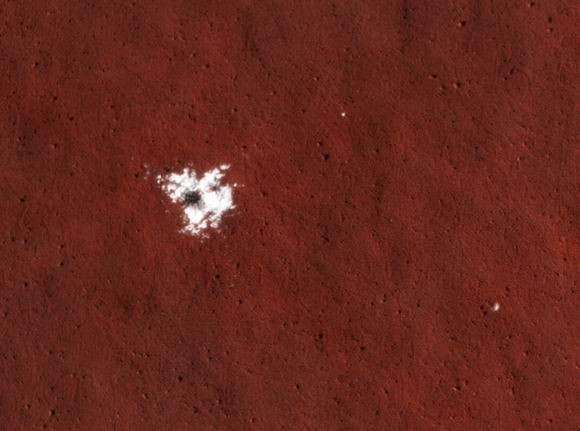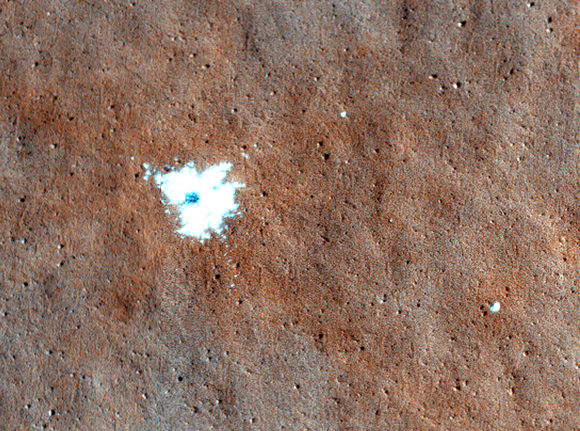[/caption]
Fresh impact craters on Mars have revealed more evidence of stable ice that’s been hiding just beneath the surface all along, say scientists working on images sent back by the HiRISE camera aboard NASA’s Mars Reconnaissance Orbiter.
The craters appeared sometime between January and September of last year, in areas that had been previously imaged without them prior to January 2008. The impacts served as “natural probes” to excavate evidence that gets to a long-standing question about ice on Mars: where is it stable, and where is it residual, in the process of sublimating away?
Study leader Shane Byrne, of the University of Arizona’s Lunar and Planetary Laboratory, presented the new set of images last week, at the Lunar and Planetary Science Conference in Texas.
Computer models agree that Mars contains stable high-latitude ice, but researchers have encountered difficulty deciding the quantity and geographical boundary of the ice, partly because they can’t see it beneath the surface and partly because pinning down an indirect measure of sub-surface ice — a long-term, global average water vapor concentration in the atmosphere — has proved challenging.

The new craters are a significant clue, because they hit not in the high latitudes where planetary scientists are fairly certain about stable ice, but in the mid-latitudes where the ice’s reach is unclear.
“Here we report on natural probes of the Martian subsurface which have ‘detected’ ice in this critical mid-latitude zone,” wrote Byrne and his co-authors.
“In five such cases (with latitudes spanning 43.3° to 55.6° N), these impacts have excavated bright material which in High Resolution Imaging Science Experiment (HiRISE) data have a brightness and color consistent with water ice.”
Each of the five new craters is a few meters in diameter, several decimeters deep and with associated bright material a few meters across, the authors report. Four of them showed no spectral evidence of water ice. But one proved a jackpot.
“Spectra from this site show clear water ice absorption features at 1.25, 1.5 and 2 ?m,” the team reported. Exposed surface ice is not expected to be stable at the latitudes, and the team has already noticed shrinkage and fading.
Based on atmospheric water vapor data, even stable underground ice isn’t expected to be widespread at the mid-latitudes where the reservoir was found: “Thus the ground ice exposed here is probably in the process of retreat from a previously larger extent,” the authors wrote.
Source: LPSC proceedings


So maybe one of the five impacts was caused by an object that carried the water ice with it:
“five such cases”
“these impacts have excavated bright material which … have a brightness and color consistent with water ice”
“Four of them showed no spectral evidence of water ice. But one proved a jackpot”
“Spectra from this site show clear water ice absorption features”
When we finally do get manned bases on Mars, they better think about being deep underground or have one tough shield overhead.
The fact of not only these images but that the rovers have found multiple meteorites in the relatively small places they have surveyed proves that the Red Planet gets hit by substantial meteorites a lot.
Lots of meteor impacts – so where are all the organics that the meteors would deliver? Instead of the “God of War”, Mars should be considered the “God of Magicians”.
@TD
Asteroids delivers metal in the most cases.
Comets delivers organics and ice.
There´s lots of asteroids in the mars near space, and not too much comets hanging around…
So, it´s just a question of logic.
Mars is a real enigma isn’t it? It certainly is a real teaser with the water and CO2 ice, and now what seems to be liquid saline droplets on the leg of Phoenix:
http://www.planetary.org/blog/article/00001890/
My money is on microbes being found eventually, either Martian in origin, from Earth meteorites or possibly from comets. I find it difficult now to believe that Mars is biologically dead.
Savino – I guess I was thinking F-class asteroids…..like the one that just hit Africa and had a lot of “cooked carbon” in it. Over the billions of years, why doesn’t Mars have a lot of that. Very strange.
Anne:
If you want to use the Greek letter mu ( µ ) in web postings and you’re using some flavour of Microsoft then:
1. hold down the left ALT key
2. type 0181 on the number pad (not the top row of the main keyboard).
3. release the ALT key
4. …et voila! a µ !
It has worked in 99% of the cases I’ve typed it.
A few others:
0176 = °
0177 = ±
0178 = ²
0179 = ³
btw: great use of “decimetres” – the handy, yet forgotten metric length.
I think Mars is somewhat like a cocoon holding in all its resources against a harsh enviroment. So the first thing we have to do when we get there is dig.
Just had a thought they should send the biggest bomb they could send and blow a hell of crater into the equator and see whats going on inside..
Since when is the American Standard Code for Information Interchange “some flavour of Microsoft”, Mr. Watchful S. Guardian?
Microsoft was founded in 1975, but ASCII Code was already introduced in 1967.
Doll: I think he means that the ALT-CODE system for entering the µ symbol only works under microsoft OS’s
Hi Maxwell, just call me dollhopf
any problems with that? 🙂
You guys keep asking why Mars doesn’t have or reveal this or that thing, like organic molecules and carbon.
Maybe it is because we have sent so few landers and rovers that have actually made it to the surface intact and operated for more than a few months.
The planet’s surface area equals all the dry land on Earth – and you expect a few rovers that take years to travel a couple of miles and a few orbiters hundreds of miles up to answer all these questions?
Plus NASA is very afraid to admit to a few drops of water on the Martian surface, so don’t expect them to admit to life or much else any time soon.
If they are to send the biggest bomb to Mars- they should also consider if they are at risk of hitting a few native wildlife (bacteria) in the process!
Also when we eventually get there we should also start digging mines to see whether we hit water.